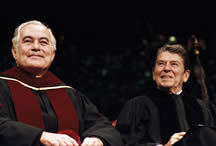
For local residents who might have wanted a glimpse of Martin Sheen, Notre Dame’s 163rd commencement was a tough ticket. It wasn’t always so.
The earliest commencements at Notre Dame were community affairs, meant to reach out to South Bend residents living on what was still the frontier, notes Peter Lysy, a University archivist. As frontier life became more settled, the campus filled with friends, alumni and students of all grades (including the elementary school “minims”) for a weekend.
Sunny weather in June 1889 brought the crowds to South Bend for a typical three-day event. Classrooms, students’ quarters and lecture halls were converted into temporary dormitories to accommodate the influx of guests.
Carriages lined Saint Joseph’s Lake on the Wednesday before commencement for a boat-racing competition. After a late afternoon respite, 1,800 visitors filled Washington Hall for a performance of the cantata of a sacred opera, a poetry reading by an 1874 alumnus and an overture by the University orchestra.
“It was a gathering of intellect, beauty, wealth and fashion such as is seldom seen in this part of the country,” reported the South Bend Tribune.
Since that time, says Lysy, “Commencements became the province of the graduating class and their families. Underclassmen were sent home before the festivities started.”
The 2,900 students who graduated May 18 are a far cry from the two who graduated with university degrees in 1849. The current practice of hosting undergraduate, graduate business and law school final exercises in the Joyce Center and a separate degree-conferring ceremony for students in The Graduate School reflects growth and experimentation, too. Over the years, comprehensive commencement exercises have been held on the Main Quadrangle, Washington Hall, the old Fieldhouse, the drill hall and Notre Dame Stadium.
Of the 900 men of the Class of 1949, 100 were married World War II veterans who lived with their wives in a section of campus called Vetville. At the urging of Vetville’s chaplain, Rev. Theodore M. Hesburgh, CSC, the University awarded diplomas to the veterans’ wives, which recognized them for having “survived the postwar hardships of South Bend housing, the rigors of Indiana weather, and with courage beyond the call of duty [having] helped her husband to a happy graduation.”
Throughout the 1950s and ‘60s, thanks largely to Hesburgh’s connections as University president, commencement began to attract more prominent speakers. Notables included Chief Justice Earl Warren in 1957, John A. McCone, the chairman of the Atomic Energy Commission, in 1959 and presidential aspirant Eugene J. McCarthy in 1967.
The 1960 commencement had an all-star cast. President Dwight D. Eisenhower, the first U.S. chief executive to speak at the University, gave the address, and the beloved Dr. Tom Dooley, a former ND student already famous for his work in the jungles of Southeast Asia, received an honorary degree. The baccalaureate Mass was celebrated by Cardinal Giovanni Battista Montini, who later became Pope Paul VI.
Oh, those champagne corks
Student behavior at commencement was a perennial headache for University administrators. In the late 1970s, officials were on the lookout for everything from fireworks to signs and banners in an effort to crack down on misbehavior at ceremonies. Richard Conklin, the University’s spokesman at the time, remembers “a screening process designed to uncover contraband, especially champagne bottles, which were popular.”
Screening was critical in 1981, the year Ronald Reagan gave the commencement address. It was the president’s first appearance outside Washington since the assassination attempt on him that March. The Secret Service, also jittery after an attempt on the life of Pope John Paul II the previous week, was on highest alert, Conklin says.
Vocal protests against Reagan’s presence at Notre Dame created an especially tense atmosphere. “Every liberal advocacy group, including many from the Catholic left, had been waiting for an opportunity to protest what they considered Reagan’s lack of concern for society’s marginalized members,” Conklin recalls. More than 1,500 protesters marched outside the Joyce Center while Reagan spoke. Inside, a few students reportedly wore white arm bands and covered their mortar boards with white paper.
Reagan received a ND blazer after the speech and doffed his suitcoat to try it on, revealing a bulletproof vest beneath his shirt. Eager to keep that detail from the public, the Secret Service demanded all negatives from the University photographer that showed the protective vest.
“There was almost an audible sigh of relief when the ‘wheels up’ word came from the airport that afternoon,” Conklin says.
As the University community geared up for its 163rd final weekend, Lysy believes the ceremonies have become “less about one shared community than they are about individuals and their accomplishments and the accomplishments of those like them.”
Perhaps, like the old adage about weddings and bridegrooms, commencement has never really been for the faculty or the students. It has always been, Conklin contends, “for the parents, who are as proud as they are poor at the ceremony.”
Photo of Father Hesburgh and President Reagan at the 1981 Notre Dame commencement.